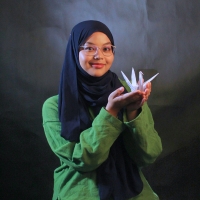Para qué sirve
Ecliptica is a tactile and audio tool that helps B2 & B3 visually impaired students explore solar and lunar eclipses. It supports SDGs 4, 9 and 10 by making science education inclusive, reducing inequalities, and bringing innovation to underserved learners.
Qué te inspiró
While volunteering as a STEM tutor, I saw how the right tools light up a classroom — and how quickly curiosity fades without them. Later, in a university ergonomics class, I noticed how often design overlooks people with disabilities in Malaysia. I realised I had never seen a single hands-on science aid for low-vision students. That led me to St. Nicholas Home, where teens shared their love for astronomy — but said they could only “listen and imagine". Their frustration shaped my goal: to create a tool they could touch and hear. Ecliptica is the result — a tactile, audio eclipse model that turns abstract lessons into multisensory experiences.
Cómo funciona
With teacher guidance, visually impaired students can manually move the Moon and Earth around the Sun to simulate solar and lunar eclipses. As the models are rotated, each phase triggers an audio prompt (e.g., “Partial Solar Eclipse”), helping students pause and explore each stage. For solar eclipses, students can feel how the Moon (light grey) gradually covers the Sun (yellow) through changing textured areas. For lunar eclipses, an indented line on the Moon shows how much has turned reddish from its original grey. High-contrast colours help students with low vision, while bold textures support those with reduced tactile sensitivity. Based on feedback, Braille is only used where necessary — many students found it easier to understand new concepts by touching shapes and textures rather than reading Braille. A headphone jack is also included for clearer audio.
Proceso de diseño
The project began with research into the educational gaps faced by visually impaired students in Malaysia, alongside an analysis of existing science tools — most designed for sighted learners. To support these findings, I interviewed visually impaired students and instructors at St. Nicholas Home in Penang. Their insights revealed a strong interest in astronomy and highlighted the lack of tools suited to their needs. To narrow the focus, I consulted a physics lecturer who recommended starting with eclipses. The phenomenon involves just three celestial bodies, making it easier to explain spatial relationships through touch. It also introduces concepts useful for understanding events like transits and occultations. Since eclipses are part of Malaysia’s science syllabus, the topic is both accessible and relevant. Using this direction, I created a design brief and sketched ideas. A mockup helped refine the model’s size, layout, and labels. The final 3D-printed prototype prioritised tactile clarity, high-contrast colours, and audio prompts to support different levels of vision. Braille was used only where necessary. Though not yet widely tested in schools, Ecliptica was shaped by user feedback and aligns with SDG 9 by promoting inclusive educational innovation.
Qué lo hace diferente
Most science tools are designed for sighted students first, with accessibility added later — often just Braille labels or simple audio. Ecliptica reverses that. It was designed from the start for B1 and B2 visually impaired learners, using touch, sound, and spatial understanding as its core. What makes it different is its focus on tactile clarity. Each surface is bold to support students with reduced touch sensitivity. The Moon, Earth, and Sun are defined by high-contrast colours and distinct textures, helping users explore positions and feel each phase. Audio cues guide students as they interact, while Braille is used only when needed — based on feedback that shape, texture, and sound are often preferred when learning new concepts. Ecliptica is inclusive by design, not adaptation, and can also be used by sighted students — encouraging shared, accessible learning.
Planes para el futuro
Ecliptica was shaped by real feedback from visually impaired students and instructors. Though not widely tested in schools yet, this is just the beginning. I hope to collaborate with educators and accessibility centres to refine the design, add multilingual audio, expand to more astronomy topics, and apply this multisensory approach to other subjects. I am also interested in furthering my studies to deepen my understanding of inclusive design. My goal is to create learning spaces where visually impaired students can access science meaningfully — alongside their peers, not apart from them.



Compartir esta página en